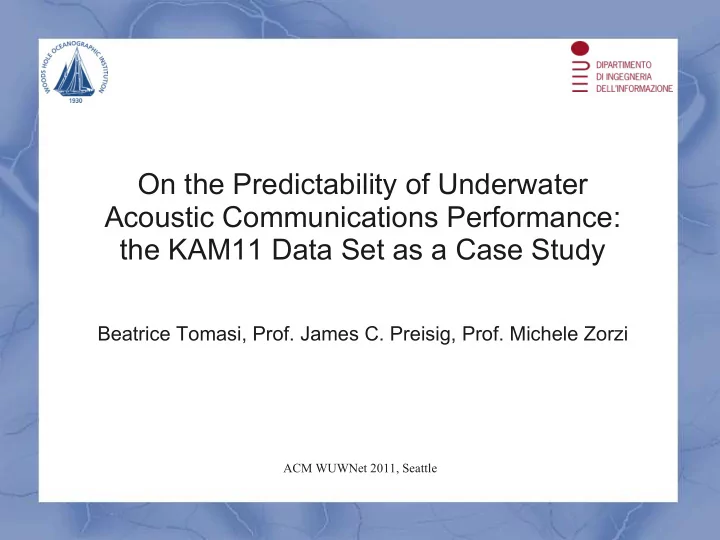

On the Predictability of Underwater Acoustic Communications Performance: the KAM11 Data Set as a Case Study Beatrice Tomasi, Prof. James C. Preisig, Prof. Michele Zorzi ACM WUWNet 2011, Seattle
Objectives and motivations Underwater Acoustic (UA) How we use these features channel main features Long propagation delays ● Networking protocols ● Frequency selectivity ● PHY ● (equalizers/OFDM/Coding) Deployment and FDMA ● Capacity dependent on the ● distance PHY (intra-packet) ● Time variability ● Networking protocols (inter- ● packet) Deployment/Mobility/Protocols ● Spatial diversity ● ACM WUWNet 2011, Seattle
Objectives and motivations Objectives Solutions To improve the efficiency of Adaptive techniques ● ● UA Communications (ARQ/HARQ/Closed Loop Power Control/Adaptive Modulation and Coding) To design networking ● Protocols with signaling ● protocols suitable for UA exchange: Networks – any MAC protocols with ACKs – RTS-CTS MAC paradigm – reactive routing ACM WUWNet 2011, Seattle protocols
Allowing Feedback means: More efficient communications and networking protocols ● Higher energy consumption ● In half-duplex systems higher occupancy of the channel ● In half-duplex systems higher delays ● Trade-offs between efficiency and robustness to time variability: Can we decrease the amount of feedback by means of predictors? ACM WUWNet 2011, Seattle
This study focuses on ● Time fluctuations of the communication performance (SNR) estimated inter packets for KAM11 ● Time correlation coefficient between consecutive SNRs ● The performance of adaptive modulation technique as a function of the feedback delay ACM WUWNet 2011, Seattle
KAM11: scenario & experiments ● Where: off the coast of Kauai m island 5 4 ● When: 171-191 Julian Dates 3 km 2011 m 0 0 ● TX: omni-directional source 1 SOURCE - 0 8 ● Central frequency fc = 13 kHz RECEIVER ● Bandwidth = 8 kHz ACM WUWNet 2011, Seattle
KAM11: scenario & experiments ● N = 6500, modulation symbols ● R = 6250 symbols/s, transmission symbol rate ● Nmax = 31 number of transmitted packets per file ● T = 280 ms, time interval between 2 successive packets ● Nf = 6 number of consecutive transmitted files Nmax T ... FILE FILE FILE ACM WUWNet 2011, Seattle 1 2 6
Sound Speed Profile ● The combination of up-down refractive parts gives rise to different propagation paths ACM WUWNet 2011, Seattle
Bad channel conditions ● 47% of the processed data (from JD 185 to JD 190) shows bad channel conditions ACM WUWNet 2011, Seattle
Good channel conditions ● 53% of the processed data (from JD 185 to JD 190) shows good channel conditions ACM WUWNet 2011, Seattle
System Model r n s n , a n RX TX Channel DFE + noise ● M = {2,4,8} PSK, available constellation sizes ● BER max = 10^(-3), maximum bit error rate as QoS ● , software decision s n , = c 0, a n w n ● , residual channel coefficient, c 0, ● , noise and residual ISI w n 2 E s =∣ c 0, ∣ ● , output SNR 2 ACM WUWNet 2011, Seattle
Performance evaluation ● Assumption: is distributed according to Nakagami c 0, ● Two successive SNRs are distributed according to a correlated Nakagami pdf. ● This model suitably represents different fading shapes and the distribution is completely defined by the second order statistics, which can be evaluated from the time series We evaluate: ● Outage probability as a function of the feedback delay ● Throughput as a function of the feedback delay ACM WUWNet 2011, Seattle
Results: input and output SNRs ACM WUWNet 2011, Seattle
Results: Time Correlation Coefficient ACM WUWNet 2011, Seattle
Results: Outage Probability ● Repetitive patterns of the system performance in time ACM WUWNet 2011, Seattle
Conclusions ● Data analysis of KAM11 ● Performance evaluation of an AM scheme as a function of the feedback delay ● Results: highly correlated performance in time intervals of a few minute ● Possibility of taking advantage of these correlated fluctuations in order to reduce the amount of feedback ACM WUWNet 2011, Seattle
Future work Open issues: ● Which environmental conditions are more responsible for such fluctuations? ● Do they likely occur? ● Which class of predictors is more effective in this time variability? ● Is the feedback rate adjustable, according to these changing channel conditions? ● How can we map time and space variability ? ACM WUWNet 2011, Seattle
Recommend
More recommend